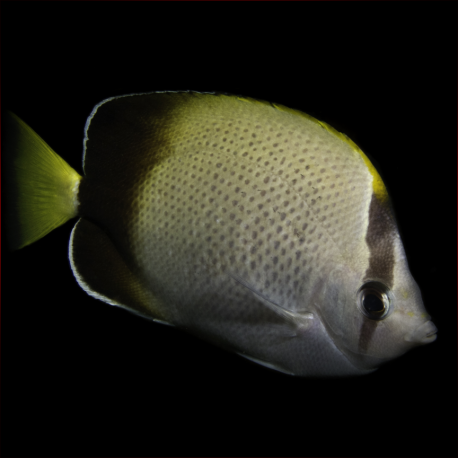More info
Datasheet
| Minimum Tank Size | 400 litres / 105.67 US gallons |
| Maximum Size | 15.0cm / 5.91inches |
| Reef Compatible | Unknown |
| Temperament | Mostly peaceful but might be aggressive towards similar species |
| Temperature | 22.2°C / 71.96°F - 25.6°C / 78.08°F |
| Specific Gravity | 1.020-1.025 |
| Carbonate Hardness | 8-12 |
| pH | 8.1-8.4 |
General Description
The African Butterflyfish, also known as Chaetodon dolosus, is part of the Chaetodontidae family characterized by their vibrant colors and intricate patterns. These fish are commonly found in the Western Indian Ocean, spanning from Somalia to Natal, South Africa, and branching out to Madagascar, Seychelles, Mauritius, and Reunion.
Aquarium Suitability
Regarding their suitability for aquariums, African Butterflyfish are deemed suitable with care due to their hardiness in well-established tanks. They require a minimum tank size of 400 liters and appreciate hiding spots among live rocks. It's vital to offer them a varied diet containing macroalgae, microalgae, small crustaceans, and zooplankton to thrive in captivity.
Demands, Care, and Hardiness
These fish are known for being hardy and can coexist in pairs if introduced simultaneously. Ensuring they have ample space for swimming and hiding places within the aquarium is crucial. African Butterflyfish must be fed a diverse diet and benefit from grazing on algae found on rocks.
Reef Suitability
The reef compatibility of African Butterflyfish is unknown, suggesting caution when considering them for a reef setup. They may interact with corals and invertebrates present in the reef environment.
Aquarium Setup
When setting up an aquarium for African Butterflyfish, it's essential to incorporate live rocks for hiding places. These fish thrive in well-run tanks with an abundance of algae for grazing. Maintaining proper water conditions with a pH of 8.1-8.4, a temperature range of 22.2-25.6°C, and a salinity level between 1.020-1.025 is crucial for their well-being.
Behaviour
African Butterflyfish are generally peaceful but may exhibit aggression towards similar species. They tend to ignore other fish and can live harmoniously in a group, though caution is advised when keeping similar species together unless they form a bonded pair.
Feeding and Diet
Their diet should consist of macroalgae, microalgae, small crustaceans, and zooplankton. Ensuring they receive a diverse diet is essential for their overall health and longevity in captivity.
Dimorphism and Captive Reproduction
Information regarding dimorphism and captive reproduction of African Butterflyfish is not provided.
Habitat and Distribution
In their natural habitat, African Butterflyfish are commonly found in the Western Indian Ocean, particularly near regions ranging from Somalia to South Africa and various islands like Madagascar and Seychelles. These fish prefer habitats with ample hiding spots and access to a diverse range of food sources, including corals and invertebrates.

